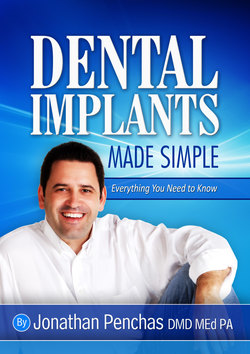Читать книгу Dental Implants Made Simple - Jonathan Penchas - Страница 6
ОглавлениеConventional Options to Replace Missing Teeth: They Often Miss the Mark
Traditional replacement teeth provide adults with missing teeth a way to regain oral function. However, conventional solutions such as dentures, partials, and bridges only address a subset of the problems associated with missing teeth. You may regain the appearance of a complete smile, but at a cost.
Full Dentures
Full dentures replace complete upper and/ or lower arches of teeth. A plastic base that floats on your gum tissue and jawbone ridge holds the prosthetic teeth in place. But without the chewing forces of natural teeth, gum tissue and jawbone mass shrink over time, causing dentures to loosen. Full dentures can be relined to accommodate gum and bone shrinkage, but this solution is only temporary. Bone and gum tissue will continue to diminish, and dentures will continue to shift, click, and cause problems with eating and speaking. Denture wearers may resort to using large amounts of adhesive to keep their teeth intact. With the scare involving zinc in over-the-counter denture paste, this method of stabilization is far from perfect and may be harmful. Additionally, dentures minimize chewing capacity by 80% when compared to natural teeth. The base of an upper denture may completely cover the roof of the mouth, restricting your ability to fully taste food.
Partial Dentures
This restorative solution is often used to replace missing teeth scattered throughout an upper or lower row of teeth. Partials are held in place with clasps that attach to healthy existing teeth. These clasps, often made of metal, can wear away at natural tooth structure, compromising the health and stability of these “anchor” teeth and increasing the risk of tooth decay and gum disease.
Crown & Bridgework
A bridge contains replacement teeth to fill a gap left by one or more missing teeth. Crown and bridgework, as it’s often called, is permanently attached to existing teeth that have been crowned to provide additional stability. The process to apply a crown requires grinding down natural tooth structure. This serves as an acceptable solution for a tooth that’s marred by extensive decay. However, destroying healthy tooth structure is never a satisfactory approach.
Ignoring the Problem
The least beneficial way to deal with missing teeth? Ignore them! If you choose this route, you’ll likely experience pain, impaired oral function, a diminished appearance, and more tooth loss. Research shows that if a missing tooth isn’t replaced, up to 20% of adjacent teeth will be lost in the next 4 to 8 years. One missing tooth sets in motion a downward spiral of events that negatively impacts the quality – and potentially the length – of your life.
